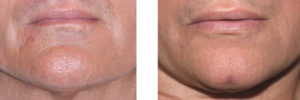A cleft or dimple of the chin is a visible indentation in the midline of the chin prominence. It can be small or quite deep and its presence is genetically determined. (dominant gene) It has appeared on many well known faces and most people can quickly name at least one famous person who has one. It has been said to be present because there is a V or Y-shaped fissure on the bony chin button. It has been reported that this fissure in the chin is the result of incomplete fusion of the left and right halves of the jaw during fetal development. Having done a lot of chin surgery, I don’t think this is exactly accurate. I have yet to see a cleft chin where the bone looks incompletely fused. It is a mere notch in an otherwise very well formed and well united manidbular symphysis.

Other patients who have a cleft in their chin would like it removed. This is a bit trickier but can still be done. ( I should say improved) From inside the mouth, the muscular attachments to the chin fissure are released. The space formed between the released muscle and the bone must be filled to prevent reattachment and ongoing external chin indentation. The best interpositional graft is a dermal-fat graft which is a natural filler. This does require a harvest site and a scar somewhere with graft dimensions being at least 1 x 2 cms. The buccal fat pad can also be used. Another option is cadaveric or animal-derived dermis but the infection risk is a little higher as it revascularizes much slower. Chin dimples that are released in this way will not always make the chin perfectly smooth. In those chin clefts which are really deep and inverted, one has to use an external skin approach to level out the skin. In this case, the scar may be worth it given the depth of the groove which was originally present.
Cleft or dimples of the chin can be surgically created or removed. Using an intraoral or submental approach, the chin bone and mentalis muscle can be molded or released. The use of an external skin incision has been advocated by some but this leaves the potential risk of a poor scar in a very visible location. Its use should be reserved only for the most severe cases of cleft chin release.
Dr. Barry Eppley
Indianapolis, Indiana


